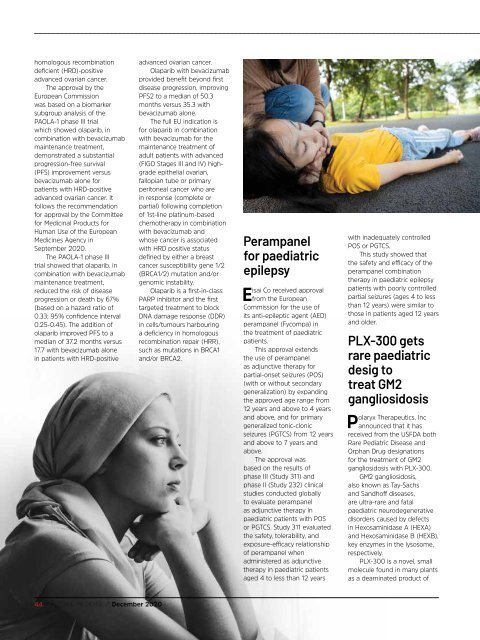You also want an ePaper? Increase the reach of your titles
YUMPU automatically turns print PDFs into web optimized ePapers that Google loves.
homologous recombination<br />
deficient (HRD)-positive<br />
advanced ovarian cancer.<br />
The approval by the<br />
European Commission<br />
was based on a biomarker<br />
subgroup analysis of the<br />
PAOLA-1 phase III trial<br />
which showed olaparib, in<br />
combination with bevacizumab<br />
maintenance treatment,<br />
demonstrated a substantial<br />
progression-free survival<br />
(PFS) improvement versus<br />
bevacizumab alone for<br />
patients with HRD-positive<br />
advanced ovarian cancer. It<br />
follows the recommendation<br />
for approval by the Committee<br />
for Medicinal Products for<br />
Human Use of the European<br />
Medicines Agency in<br />
September <strong>2020</strong>.<br />
The PAOLA-1 phase III<br />
trial showed that olaparib, in<br />
combination with bevacizumab<br />
maintenance treatment,<br />
reduced the risk of disease<br />
progression or death by 67%<br />
(based on a hazard ratio of<br />
0.33; 95% confidence interval<br />
0.25-0.45). The addition of<br />
olaparib improved PFS to a<br />
median of 37.2 months versus<br />
17.7 with bevacizumab alone<br />
in patients with HRD-positive<br />
advanced ovarian cancer.<br />
Olaparib with bevacizumab<br />
provided benefit beyond first<br />
disease progression, improving<br />
PFS2 to a median of 50.3<br />
months versus 35.3 with<br />
bevacizumab alone.<br />
The full EU indication is<br />
for olaparib in combination<br />
with bevacizumab for the<br />
maintenance treatment of<br />
adult patients with advanced<br />
(FIGO Stages III and IV) highgrade<br />
epithelial ovarian,<br />
fallopian tube or primary<br />
peritoneal cancer who are<br />
in response (complete or<br />
partial) following completion<br />
of 1st-line platinum-based<br />
chemotherapy in combination<br />
with bevacizumab and<br />
whose cancer is associated<br />
with HRD positive status<br />
defined by either a breast<br />
cancer susceptibility gene 1/2<br />
(BRCA1/2) mutation and/or<br />
genomic instability.<br />
Olaparib is a first-in-class<br />
PARP inhibitor and the first<br />
targeted treatment to block<br />
DNA damage response (DDR)<br />
in cells/tumours harbouring<br />
a deficiency in homologous<br />
recombination repair (HRR),<br />
such as mutations in BRCA1<br />
and/or BRCA2.<br />
Perampanel<br />
for paediatric<br />
epilepsy<br />
E<br />
isai Co received approval<br />
from the European<br />
Commission for the use of<br />
its anti-epileptic agent (AED)<br />
perampanel (Fycompa) in<br />
the treatment of paediatric<br />
patients.<br />
This approval extends<br />
the use of perampanel<br />
as adjunctive therapy for<br />
partial-onset seizures (POS)<br />
(with or without secondary<br />
generalization) by expanding<br />
the approved age range from<br />
12 years and above to 4 years<br />
and above, and for primary<br />
generalized tonic-clonic<br />
seizures (PGTCS) from 12 years<br />
and above to 7 years and<br />
above.<br />
The approval was<br />
based on the results of<br />
phase III (Study 311) and<br />
phase II (Study 232) clinical<br />
studies conducted globally<br />
to evaluate perampanel<br />
as adjunctive therapy in<br />
paediatric patients with POS<br />
or PGTCS. Study 311 evaluated<br />
the safety, tolerability, and<br />
exposure-efficacy relationship<br />
of perampanel when<br />
administered as adjunctive<br />
therapy in paediatric patients<br />
aged 4 to less than 12 years<br />
with inadequately controlled<br />
POS or PGTCS.<br />
This study showed that<br />
the safety and efficacy of the<br />
perampanel combination<br />
therapy in paediatric epilepsy<br />
patients with poorly controlled<br />
partial seizures (ages 4 to less<br />
than 12 years) were similar to<br />
those in patients aged 12 years<br />
and older.<br />
PLX-300 gets<br />
rare paediatric<br />
desig to<br />
treat GM2<br />
gangliosidosis<br />
Polaryx Therapeutics, Inc<br />
announced that it has<br />
received from the USFDA both<br />
Rare Pediatric Disease and<br />
Orphan Drug designations<br />
for the treatment of GM2<br />
gangliosidosis with PLX-300.<br />
GM2 gangliosidosis,<br />
also known as Tay-Sachs<br />
and Sandhoff diseases,<br />
are ultra-rare and fatal<br />
paediatric neurodegenerative<br />
disorders caused by defects<br />
in Hexosaminidase A (HEXA)<br />
and Hexosaminidase B (HEXB),<br />
key enzymes in the lysosome,<br />
respectively.<br />
PLX-300 is a novel, small<br />
molecule found in many plants<br />
as a deaminated product of<br />
44 / FUTURE MEDICINE / <strong>December</strong> <strong>2020</strong>

















